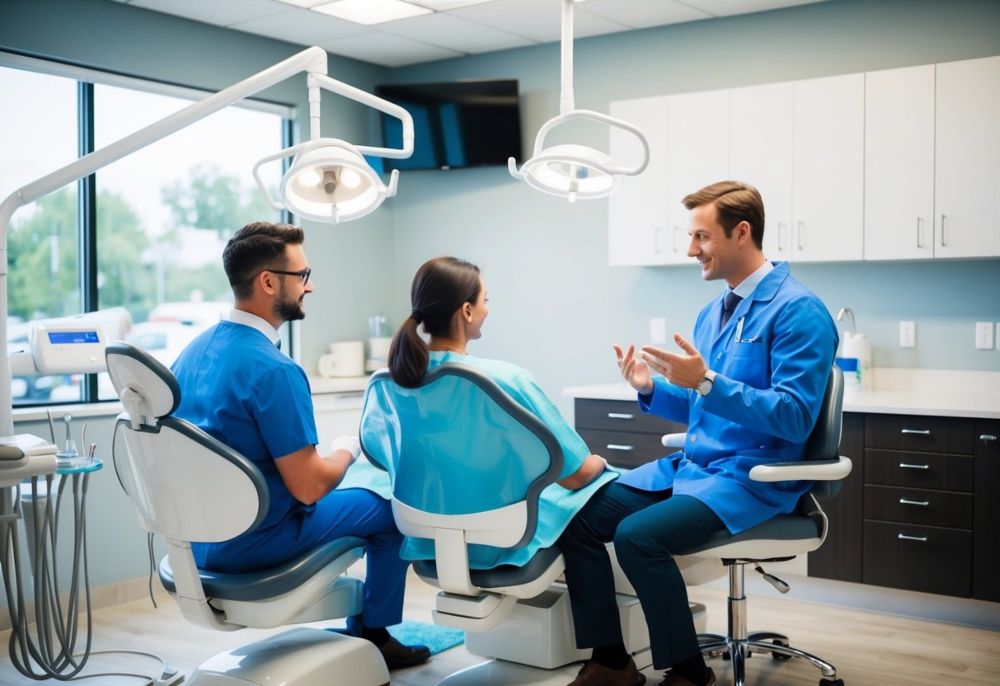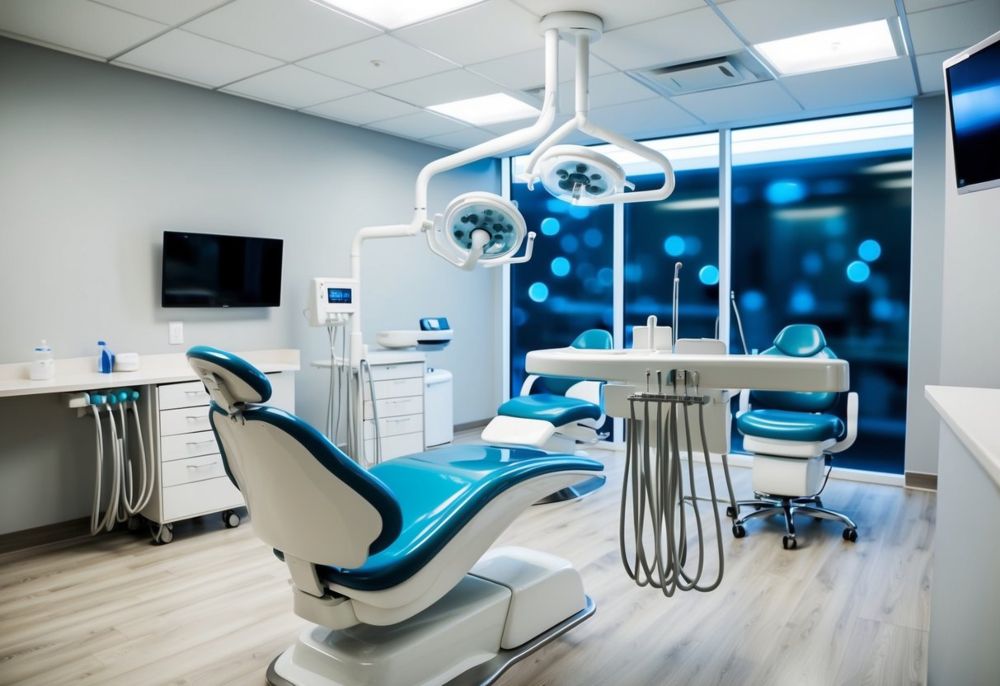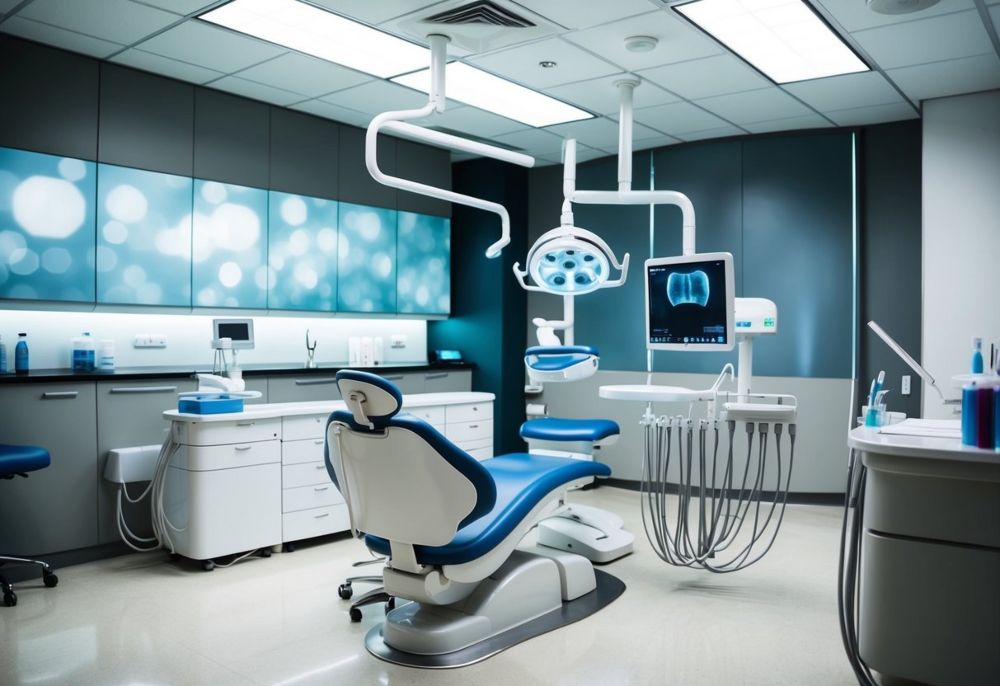

Dentists need top-notch equipment to provide quality care. However, the high costs can be a challenge. Dental equipment financing offers a solution, allowing dentists to get the necessary tools without breaking the bank.
Dental equipment loans can cover up to $150,000 for new or used items such as chairs, X-ray machines, and CAD/CAM systems.
There are many ways to finance dental equipment. Banks, online lenders, and equipment vendors all offer options.
Each choice has its pros and cons. Some loans use the equipment as collateral, making them easier to get.
Dentists should consider their needs and budget when picking a financing option. Comparing different choices can help them find the best deal for their practice.

Dental equipment financing helps dentists get the tools they need to run their practices. It allows them to spread out costs over time and keep up with new tech.
Dental technology keeps getting better, but it’s not cheap. A basic dental chair can cost $3,000 to $10,000, and more complex items like 3D imaging systems may run $50,000 or more.
New tech helps dentists work faster and better. However, the high price tags can be hard to manage. Many dentists find it tough to pay for everything at once.
Keeping up with new gear is key to staying competitive. Patients expect modern tools and methods; old equipment can slow down practice and drive patients away.
Dental equipment financing lets dentists get what they need now and pay over time. This helps manage cash flow and keeps money free for other needs.
Financing options often include:
With financing, dentists can budget for monthly equipment costs, making planning and growing the practice easier.
Financing also lets dentists upgrade more often. They can keep up with new tech without waiting to save up large sums of money.
Some deals even include maintenance and support. This can save money and headaches down the road.

Dental equipment financing helps dentists access modern technology without large upfront costs. It allows practices to stay competitive and provide better care.
Dental equipment financing lets practices spread out payments for expensive tools, making it easier to afford the latest technology.
New dental equipment often costs tens of thousands of dollars. Financing turns this big expense into smaller monthly payments.
Dentists can get the gear they need now and pay over time. This helps practices stay up-to-date without draining their cash reserves.
Financing also offers tax benefits. Practices may be able to deduct interest payments on equipment loans.
Modern dental equipment improves diagnoses and treatments. Financing helps dentists get this tech sooner.
Advanced tools like 3D imaging systems spot issues earlier. Digital X-rays reduce radiation exposure for patients.
CAD/CAM systems let dentists make crowns in one visit, saving patients time and improving their experience.
Laser systems enable more precise, less painful treatments. Intraoral cameras help educate patients about their oral health.
With financing, dentists can offer these improved services right away, leading to better outcomes and happier patients.

Dentists have several options for funding new equipment for their practices. These options vary in terms of cost, flexibility, and long-term financial impact.
Dental equipment financing through traditional business loans is common for many practices. Banks and specialized lenders offer these loans specifically for purchasing dental equipment.
Loan amounts can reach up to $150,000 or more, depending on the lender and the dentist’s qualifications. This option allows dentists to own the equipment outright once the loan is paid off.
Interest rates and terms vary, but many lenders offer competitive rates for qualified borrowers. The equipment often serves as collateral, which can help secure better terms.
Repayment typically involves fixed monthly payments over a set period, making it easier for practices to budget and plan.
Lines of credit provide a more flexible option for dental practices. They allow dentists to borrow funds up to a predetermined limit as needed.
This flexibility can be useful for purchasing multiple pieces of equipment over time or handling unexpected equipment needs. Interest is only paid on the amount borrowed, not the entire credit line.
Some lenders offer revolving lines of credit, where the available credit replenishes as the borrowed amount is repaid. This feature can be helpful for ongoing equipment upgrades or replacements.
Lines of credit may have variable interest rates, which can be beneficial if rates are low but may lead to higher costs if rates rise.
Leasing dental equipment is another popular financing option. It allows practices to use new equipment without the large upfront cost of purchasing.
Monthly lease payments are often lower than loan payments, which can help with cash flow. Leases also typically include maintenance and upgrades, reducing unexpected costs.
At the end of the lease term, dentists can return the equipment, buy it at a reduced price, or lease newer models. This flexibility helps practices stay current with technology.
Leasing can be tax-deductible as a business expense, potentially offering more immediate tax benefits than depreciation on owned equipment.
One drawback is that leasing may cost more in the long run than buying, especially for equipment with a long useful life.
Equip your dental practice without draining your budget. Small Business Assets & Capital’s Dental Equipment Loans can cover essential items from chairs to CAD/CAM systems, up to $150,000! Get started now to secure the latest technology for exceptional patient care.
If you’re ready to get started, call us now!
Dentists face a crucial decision when acquiring new equipment: lease or buy? This choice impacts cash flow, tax benefits, and long-term financial health. Let’s explore the key factors to consider.
Dental equipment leasing offers several benefits. It requires less money upfront, preserving cash for other practice needs. Leasing allows dentists to upgrade equipment more frequently, keeping up with technological advancements.
Monthly lease payments are often tax-deductible, potentially lowering overall costs. Leasing companies typically handle maintenance and repairs, reducing unexpected expenses.
For new practices or those expanding, leasing can be a smart way to quickly acquire multiple pieces of equipment without a large capital outlay.
Purchasing dental equipment builds valuable assets for the practice. Over time, buying often costs less than leasing, especially for equipment with a long lifespan.
Ownership provides complete control over the equipment, including the ability to modify or sell it. Dentists can claim depreciation on owned equipment, potentially leading to significant tax savings.
Buying eliminates ongoing lease payments, improving cash flow in the long run. It’s often better for established practices with stable finances and a clear long-term vision.
When deciding between leasing and buying dental equipment, consider these factors:
Analyze the total cost of ownership over the equipment’s expected lifespan. This includes purchase price or lease payments, maintenance, and potential resale value.
Consider consulting a financial advisor to determine the best option for your situation. They can help create a detailed cost comparison and assess the impact on your practice’s finances.
Stay on top of dental tech advancements! With Small Business Assets & Capital’s Flexible Lines of Credit, you can acquire essential equipment when you need it without a long wait. Explore hassle-free financing that keeps your practice competitive and efficient.
If you’re ready to get started, call us now!
Getting dental equipment financing involves a step-by-step process. Dentists need to prepare documents, meet eligibility criteria, and navigate the application process. Understanding the timeline and following best practices can help speed up approval.
To qualify for dental equipment loans, dentists typically need:
Required documents often include:
Newer practices may face stricter requirements. To speed up the process, lenders might ask for a business plan and financial projections.
The application process for dental equipment financing usually follows these steps:
Many lenders offer online applications. This can make the process faster and easier. Some even provide pre-qualification tools to check rates without affecting credit scores.
Approval times vary by lender. Some offer decisions in 24-48 hours, while others may take a week or more.
To speed up the process:
Equipment financing loans can often be approved faster than general practice loans because the equipment serves as collateral. Dentists in a hurry might want to look into lenders specializing in quick approvals.
SBAC Funding offers dentists competitive rates, quick approvals, and strong support for practice growth. Their tailored loan options help dental practices acquire essential equipment affordably.
SBAC Funding provides affordable dental equipment financing solutions with competitive interest rates.
Dentists can choose from various repayment terms to fit their budget and cash flow needs.
Flexible options include:
These choices allow practices to match loan payments with their revenue cycles. SBAC also offers low-cost dental equipment loans with no prepayment penalties, allowing dentists to pay off their loans early if desired.
SBAC Funding streamlines the loan application process for dentists. Their fast-approval dental loans can be processed within days, not weeks.
Key features:
SBAC offers tailored loan options to meet specific practice needs.
Loan amounts range from small equipment purchases to complete office setups. This flexibility helps new and established dental practices access the funding quickly.
SBAC Funding goes beyond just providing loans. They offer comprehensive support to help dental practices thrive and expand.
Support includes:
SBAC’s healthcare lending specialists understand the unique needs of dental practices. They can advise on cost-effective equipment choices and financing strategies to maximize return on investment. This support helps dentists make informed decisions about equipment purchases and practice expansion.
Dental equipment financing makes cutting-edge technology accessible to practices of all sizes. It allows dentists to upgrade their equipment without a large upfront investment, helping level the playing field between small practices and large clinics.
Financing options like loans and leases give dentists flexibility. They can choose terms that fit their budget and cash flow needs. Some lenders offer 100% financing for qualified borrowers.
Accessible financing helps practices stay current with the latest dental innovations, ensuring patients receive the best possible care using modern equipment and techniques.
Equipment financing supports dental practice growth in several ways. It frees up working capital for other business needs, like marketing or hiring staff, and allows practices to expand their service offerings with new equipment.
Financing allows dentists to acquire technology that improves efficiency and patient outcomes. Digital x-ray systems and CAD/CAM machines can speed up procedures and enhance accuracy.
Better equipment often leads to improved patient experiences and satisfaction, which can help attract new patients and retain existing ones.
Dental chairs, X-ray systems, and CAD/CAM equipment are common items that are financed to enhance care.
Selecting the right financing partner is crucial for long-term success. Dentists should look for lenders with experience in the dental industry. These lenders understand the unique needs and challenges of dental practices.
Compare offers from multiple lenders to find the best rates and terms.
Consider factors like interest rates, repayment periods, and any prepayment penalties. Some lenders specialize in dental practice loans and may offer more tailored solutions.
Look for a financing partner that offers excellent customer service and support. They should be responsive to questions and concerns throughout the loan process.
A good partner will work with you as your practice grows and your financing needs change.
Make smart financial moves with Small Business Assets & Capital’s Dental Equipment Financing. Access modern tools without a hefty upfront cost—spread payments, enhance care quality, and enjoy manageable terms designed for your growth. Partner with us today to elevate your practice!
How can dentists qualify for medical equipment financing?
Dentists can qualify for equipment financing by meeting certain criteria.
Lenders often look at credit scores, time in business, and annual revenue.
New dentists may need to provide a business plan, while established practices typically need to show financial statements and tax returns.
What are the terms and interest rates for dental equipment loans?
Dental equipment loans usually have terms ranging from 1 to 7 years. Interest rates vary based on creditworthiness and loan type.
Rates can start as low as 5% for well-qualified borrowers. Some lenders offer fixed monthly payments to help with budgeting.
What are the benefits of financing dental equipment instead of paying cash?
Financing dental equipment helps preserve cash flow. It allows dentists to get needed equipment without depleting savings.
Loans can also provide tax benefits. Interest payments may be tax-deductible, reducing the overall cost of the equipment.
What types of dental equipment can be financed with a dental equipment loan?
Dental equipment loans can cover a wide range of items, including dental chairs, X-ray machines, and imaging systems.
Smaller tools like handpieces and sterilization equipment can also be financed. Some lenders even cover software and technology upgrades.
How does credit history impact the approval for a dental equipment loan?
Credit history plays a significant role in loan approval. Higher credit scores often lead to better terms and lower interest rates.
Lenders may still approve loans for those with less-than-perfect credit. However, these loans may have higher rates or require additional collateral.
Are there flexible repayment options available for dental equipment financing?
Many lenders offer flexible repayment options. These can include seasonal payments for practices with fluctuating income.
Some loans allow for deferred payments at the start. This gives dentists time to set up new equipment before payments begin.